
Pull Tab Easter Egg Hunt
(printable pull tab template)
Pressure Sensor Easter Egg Hunt
(printable pressure sensor template)
Dot to Dot Easter Bunny
(printable dot to dot template)
(Note: These templates need to be printed using landscape orientation with double-sided printing, flipped on the short edge.)
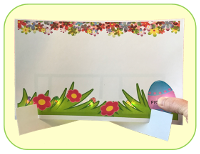 There are so many fascinating STEM investigations for us to solve beyond the world of paper circuits, but with Easter just around the corner, we couldn’t pass up this creative opportunity to delve a little deeper into paper switches and sensors.
There are so many fascinating STEM investigations for us to solve beyond the world of paper circuits, but with Easter just around the corner, we couldn’t pass up this creative opportunity to delve a little deeper into paper switches and sensors.
If this is the first time you and your kids have experimented with paper circuits you may want to take a look at the paper circuit tutorials from our Case of the Broken Valentine Circuit post. If you and your kids are already paper circuit whizzes, then feel free to use the above links to go straight to the Easter circuit of your choice.
Switches and Sensors
A switch is the part of the circuit designed to open and close a gap in the circuit’s conductive path. When the switch closes the gap, the circuit is complete and the electric current will flow. When the switch opens the gap though, the circuit is incomplete, and the electric current is unable to flow through the circuit.
Think back to the paper circuit tutorials from our Case of the Broken Valentine Circuit post. The flap at the bottom right corner of the circuit is actually a simple on/off switch. When you fold in the flap, the circuit is closed, and the LEDs light up.
Our first Easter egg hunt circuit uses a pull tab switch. The first fence post to the right of the Easter Bunny is designed to act as our pull tab. When you move the fence post up or down, depending on its current position, the section of fence wrapped in copper foil tape will slide into position, close the circuit, and the LEDs will light up. Congratulations, you just found the missing Easter eggs.
A sensor is similar to a switch but it will only turn on under specific conditions. Our second Easter egg hunt circuit uses a pressure sensor to light the LEDs behind the hidden Easter eggs. When your sensor circuit is complete have your kids press the giant Easter egg. Can they explain what just happened?
Our third template is a dot to dot Easter Bunny for the younger kids to enjoy. The bunny’s left ear acts as the switch to turn the circuit on and off. Fold the ear and watch the bunny’s eyes light up.
These three Easter templates are just the tip of the iceberg when it comes to paper circuits. After your kids complete these Easter circuits, have them surprise you with designs of their own. The possibilities are endless.
Note: These Easter circuits will cost about $1.50 per circuit, depending on the cost of the supplies at the time. Keep in mind that your upfront cost will vary depending on the number of circuits you’re building. The more you can purchase up front, the cheaper the overall cost per circuit will be. Since our Easter circuits use the same materials as we used in our Case of the Broken Valentine Circuit post, a lot of our findings below may sound familiar to you. We included all results here so you don’t have to jump between posts. We continue to use the CR2032 3V coin cell battery. We first investigated this battery with two others during our Case of the Vibrating BrushBot investigation. It best fit our needs then, and it best fits our needs now. The SONY CR2032 3V coin cell battery from Amazon. Note: We go through quite a few of the CR2032 coin cell batteries, so we purchase them from Amazon in the 20 pcs packs. Every SONY battery in these 20 pcs packs have worked for us so we are going to try the 50 pcs pack next. We’ll let you know how the larger packs work. Conductive materials allow the electrical charge to flow across the entire surface of the material. During our investigation, we played with conductive fabric cloth adhesive tape, 1/4″ copper foil tape, 1/2″ copper foil tape, and conductive fabric tape patches. The 1/4″ copper foil tape from Amazon. Note: If you choose to use the copper foil tape be sure to purchase rolls that use conductive adhesive. This ensures that both sides of the tape are conductive. We purchased the fabric tape patches to attach the LED legs to the copper tape. Although the patches worked as planned we decided to use additional strips of the copper tape instead. This kept the list of needed supplies down and you should have plenty of extra copper tape. If you already have copper tape without conductive adhesive or purchased the wrong tape by mistake don’t panic. Fold over a small section of the copper tape at the end so the adhesive sides touch creating a flap that is conductive on both sides. Once you have this flap you can use scotch tape to attach it to an LED, battery, or the next piece of copper tape in your design. This should work where ever you need a connection. Both the 1/4″ and 1/2″ copper tape will twist and curl onto itself if you peel off the backing all at once. We found it easiest to peel off the backing as we applied the tape to the template instead. We chose the 1/4″ copper tape because it was more cost-effective when we bought it and the thinner strips were easier to work with when a design had LEDs close together. If you find a better deal on 1/2″ tape it’s easy to cut in half lengthwise. Light-emitting diodes (LEDs) come in a variety of colors and sizes. We tried both the 3mm and 5mm two-legged bulbs because they didn’t require any soldering which helped keep our projects simple. As you can see they come in red, yellow, green, blue and white bulbs and the clear bulbs by the coin cell battery in the picture above are flashing RGB (red, green, blue) bulbs which are cool too. The 3 mm LEDs from Amazon. LED polarity does matter, and the LED will only work when the positive (long) leg is attached to the positive side of the battery and the negative (short) leg is attached to the negative side of the battery. Note: We used permanent markers to color the positive legs red and the negative legs black. Once your kids bend the legs to use in their circuits it can be easy to forget which leg is which. Murphy’s Law – “Anything that can go wrong will go wrong” And with paper circuits, there are a few areas that will undoubtedly go wrong sooner or later. We’ve composed a list of tips for you to check out if your LEDs don’t light up. 1. Battery 1.2 Make sure the two thin strips of foam tape are located in the areas marked ‘foam tape’ on both sides of the light gray circle. If the foam tape is located within the circle they could prevent a good connection between the copper tape and battery when the Easter egg sensor is pressed (Image 1, bottom left arrow). 1.3 Make sure the copper tape that runs up the side, and across the top of the battery does not touch the copper tape under the battery. If these two pieces of tape touch you could get a short circuit (Image 1, bottom right arrow). 1.4 Make sure the battery is actually working. Slide a spare LED around the sides of the battery making sure the positive and negative legs are in the correct position. If the spare LED lights up, you’ll know the battery is working and is not the issue (Image 2). 2. LEDs 2.1 Press the giant Easter egg from the front of the circuit template until you make contact with the battery attached to the back. While pressing the egg, use the spare LED to bridge each LED gap where an LED did not light up. Touch the positive leg to the positive side of the circuit and the negative leg to the negative side of the circuit. If the spare LED lights up, you’ll know the original LED is the problem (Image 3). 2.2 If step 2.1 proved there’s an issue with the LED, press the LED legs firmly to the copper tape in the circuit to see whether the LED lights up. If it does, you need to create a tighter connection to the copper tape. Firmly press the layers of copper tape together to see if that helps. 2.3 If step 2.2 doesn’t light up the LED, check to see if the LED legs are in the proper position. If the LED still doesn’t light up, you will most likely need a new LED. 3. Copper Foil Tape If both the battery and LED are working, there may be a bad connection with the copper tape. Look for a break or tear in the tape, most likely in one of the corner folds. If you find a tear you can repair the area by applying another strip of tape over the damaged area. Note: We have not had any issues with the copper tape during our investigations. Most of our issues were with the LED legs in reverse direction or an upside-down battery. As we mentioned during our investigation summary, one option is to use permanent markers to color the positive LED legs red and the negative LED legs black to prevent reversed leg positioning. The next three tabs will take you through the step by step process for building our three Easter circuits. These circuits are parallel circuits. They need a single source of electricity and contain a separate conductive pathway for each LED in the circuit. Pull Tab Easter Egg Hunt During our investigation, we found creating a pull tab switch out of a fence post an ideal way to show what a little imagination can do. Feel free to follow our design or challenge your older kids to design a switch of their own. 1.1 You need to print your circuit template double sided. Image 1 above shows the front and back of the template printed separately only to show you what both sides look like. You will also need 3 flashing LEDs, a coin cell battery, a 3/4″ piece of foam tape, a 3/4″ piece of scotch tape, and around 36″ of copper foil tape with conductive adhesive (Image 2). We’re using flashing LEDs, but your kids can choose any colors available. It’s always more fun for the kids when they can add a little of their own style to these projects. 2.1 Test your battery and LEDs. The longer leg of the LED is positive, and the shorter leg is negative (Image 3). You can also use the flat side of your LED to determine which leg is negative as it’s the leg closest to that side. We had a hard time finding the flat side during our investigation though, so we always looked at the leg length when testing. 2.2 Polarity is important with LEDs so be sure to place the positive leg on the positive side of the battery and the negative leg on the negative side. If both the battery and LED are working you should see the LED light up (Image 4). If the LED doesn’t light up, try switching the direction of the LED legs. If it still doesn’t work, you either need a new battery or a new LED. It’s a lot easier to replace a bad battery or LED now before you start the project, so these tests are very useful. Let’s take a quick look at how our picket fence switch works before starting our step by step directions. On the front of our template the first full fence post, to the right of the bunny, will be covered by a movable post that acts as the switch (Image 5). The back of our template is where the fun begins. The spare fence post located at the top of the template will be cut out and lined with copper tape in the area marked. The three dotted lines, next to the knife symbols, are the slots for you to weave the post through before securing it to the bottom of the template. Moving the post up or down, depending on its current position, will align the fence post copper strip with the copper in the circuit which will close the circuit, allowing the LED lights to turn on and off (Image 6). 3.2 Attach the 3/4″ piece of foam tape to the gray battery circle located on the bottom right-hand side of the template. Make sure to attach the foam tape horizontally so there will be enough adhesive material to stick to the battery after the copper tape is attached (Image 9). 3.3 It’s time to attach the copper tape along the outer pathway of the circuit. Start near the top of the foam tape and follow the solid black line downward in a counter-clockwise direction, peeling the backing off as you go. Be sure to leave a small gap near the top of the foam tape to prevent the chance of a short circuit with the other end of the tape as it comes back around and is attached to the top of the battery (Image 10). Note: During our investigation, we found that if you remove the backing all at once the copper tape will twist and stick to itself. 3.4 Corners can be tricky but we’re using copper tape that’s conductive on both sides. A little twist in the tape at the corners shouldn’t be a problem. 3.5 When you reach a corner the trick is to bend the copper tape in the opposite direction from where you want to go first, creating a diagonal fold (Image 11). 3.6 Hold this folded section in place with your finger as you bend the copper tape back over the fold to continue going in the right direction. You should see a nice corner form but don’t worry if it’s messy. It gets easier with practice (Image12). Note: We found it easier to create clean corners by removing the excess white backing material each time we reach a corner. 3.7 Continue to place the copper tape along the outer black line until you reach the LED gap. Use your fingers to cut the tape and then continue to place the tape along this line from the other side of the gap (Image 13). 3.8 This next section of copper tape will stop at the gap near the knife symbols. Again, use your fingers to cut the tape to form a gap in the circuit. This gap will only be connected when the fence post switch is moved up or down (Image 14). 3.9 Continue to attach the copper tape until you reach the end of the black line just above the Battery label (Image 15). 3.10 Attach the battery, positive side up, to the foam tape (Image 16). 3.11 Continue running the copper tape along the dotted black line, and across the battery to its far edge. Be sure to stop at the edge so it doesn’t touch the copper tape from the beginning of the circuit (Image 17 & 18). Note: If this end of the copper tape touches the section of copper tape under the battery it will short circuit. 3.12 You just completed the outer pathway of the fence post circuit. It’s time to connect the first LED to the gap along the outer pathway. It’s easier to troubleshoot a problem in the circuit now before additional pathways are added. 3.13 Bend the LED legs wide enough to connect to the copper tape on both sides of the gap, line the legs up with the dotted lines and the LED to the red circle (Image 19). 3.14 Tear off two small pieces of copper tape and use them to cover the LED legs and stick them to the existing copper tape (Image 20). Note: Remember that polarity matters. The positive leg needs to connect to the side marked positive and the negative leg needs to connect to the side marked negative. 3.15 It’s time to build the switch so we can test this section of the circuit. Use scissors or a hobby knife to cut along the dotted slot lines located near the knife symbols (Image 21). Note: During our investigation, we found widening the slots with a slight side to side motion of the knife allowed the fence post to move up and down easier. 3.16 Cut the fence post out of the template section we removed in step 3.1 (Image 22). 3.17 Wrap a strip of copper tape around the post until the gray rectangular area is covered with two layers of copper tape. The thicker post will help ensure a connection with the copper tape in the circuit when the switch is moved up or down, depending on its position (Image 23). Note: During our investigations, we noticed that some rolls of copper tape felt thicker than others. Add additional layers of copper tape as needed until a connection is created. 3.18 Carefully fold the fence post along the dotted lines at the bottom of the post. Fold the bottom of the post inward, at the first dotted line, so sections 1 & 2 touch each other. The bottom of the post should line up with the second dotted line (Top post, Image 24). 3.19 Now fold the post backward at the second dotted line. The bottom of the post will have an accordion style fold in it (Bottom post, Image 24). 3.20 Weave the fence post through the slots from step 3.15, starting from the back. 3.21 With the brown side of the post facing the template, gently guide the top of the fence post through Slot 1 so it comes out at the front of the template (Image 25). 3.22 From the front of the template, guide the fence post through Slot 2 so it’s at the back of the template again (Image 26). 3.23 Finally, guide the fence post through Slot 3 so the tip of the post is at the front of the template (Image 27 & 29). Note: Be careful not to pull the bottom of the fence post through the slots. 3.24 Unfold the bottom of the fence post and line it up with the bottom of the template. Use the 3/4″ piece of scotch tape to attach the bottom of the post to the bottom of the template. This will keep the post securely in place when you need to open and close the circuit (Image 28). 3.25 You are now ready to test the outer pathway of your circuit. From the front of the template gently move the fence post up or down, depending on its current position, so the strip of copper tape lines up with the circuit on the back. The fence post copper strip will form a bridge over the gap in the template, creating the connection needed to close the circuit. Note: The copper strip on the fence post in our picture will need to be moved downward until it is hidden behind the top horizontal rail of the fence (Image 29). 3.26 Once you see the LED light up you will be ready to build the other two pathways in the circuit (Image 30). Note: If your LED doesn’t light up, you should press the fence post against the template firmly to make sure there is a connection. If that does the trick, wrap additional layers of copper tape around the fence post until that section is the right thickness. If the LED still didn’t light up, you should check out our troubleshooting tips at the beginning of this post, next to the investigation tab. 3.27 Attach the copper tape to the remaining two pathways that cut vertically through the circuit. Start at the top of each line and be sure to overlap the piece of copper tape already in place so a connection is formed (Image 31, top arrows). 3.28 Run the copper tape down along both black lines. When you reach the gap in each pathway use your fingers to cut the tape and then continue placing the tape along the black line on the other side of the gap. Each pathway is complete when the copper tape overlaps the horizontal copper tape along the bottom of the circuit (Image 31, bottom arrows). 3.29 It’s time to connect the remaining two LEDs. Bend the LED legs wide enough to connect to the copper tape on both sides of the gaps, line the legs up with the dotted lines and the LEDs to the red circles, one LED per pathway (Image 32). Note: Remember that polarity matters. The positive leg needs to connect to the side marked positive and the negative leg needs to connect to the side marked negative. 3.30 Tear off two small pieces of copper tape and use them to cover the LED legs and stick them to the existing copper tape (Image 33). 3.31 Congrats! You have just finished creating your fence post switch template. Move the fence post switch up and down to watch the LEDs light up the hidden Easter eggs on the front of the template (Image 34 and 35). Note: Now that you have a working circuit you may want to use some scotch tape to secure the LED bulbs to the back of the template. You can also poke a small hole through the template near each LED if your kids would like the LEDs to shine a little brighter from the front. Pressure Sensor Easter Egg Hunt During our investigation into sensors, we found the pressure sensor to work best with our giant Easter egg. Note: We have a lot going on with this template too so follow our build steps carefully as you build your own pressure sensor circuit. 1.1 You need to print your circuit template using landscape orientation with double-sided printing, flipped on the short edge. Image 1 above shows the front and back of the template printed separately only to show you what both sides look like. The above image also shows the template with the stand cut off which you will do in step 3.1 below. 1.2 You will also need 4 flashing LEDs, a coin cell battery, a 3/4″ piece of foam tape, and around 34″ of copper foil tape with conductive adhesive (Image 2). We’re using flashing LEDs again, but your kids can choose any colors available. It’s always more fun for the kids when they can add a little of their own style to these projects. 2.1 Test your battery and LEDs. The longer leg of the LED is positive, and the shorter leg is negative (Image 3). You can also use the flat side of your LED to determine which leg is negative as it’s the leg closest to that side. We had a hard time finding the flat side during our investigation though, so we always looked at the leg length when testing. 2.2 Polarity is important with LEDs so be sure to place the positive leg on the positive side of the battery and the negative leg on the negative side. If both the battery and LED are working you should see the LED light up (Image 4). If the LED doesn’t light up, try switching the direction of the LED legs. If it still doesn’t work, you either need a new battery or a new LED. It’s a lot easier to replace a bad battery or LED now before you start the project, so these tests are very useful. 3.1 The back of the template has four scissor symbols that show you where you need to cut the template. Cut along the horizontal dotted line first. This section will be used as a stand for your completed project, so cut carefully. Fold this strip in half and cut out the rectangular sections marked with the scissor symbols at the same time, forming identical groove marks to set your finished template in (Image 5). 3.2 Let’s take a closer look at this circuit so you have a better idea of what you will be building: This pressure sensor circuit is very similar to the parallel circuit tutorial from our The Case of the Broken Valentine Circuit post. The difference is located at the power source, and how we designed the sensor used to close the circuit. The two thin strips of foam tape, at the far left of the circuit, act as spacers to prevent the copper tape from touching the battery. The circuit will only close when you firmly press the giant Easter egg from the front. When pressed, the copper tape will make contact with the negative side of the battery. The positive side of the battery will already be connected to the copper tape pathway, so no other steps will be needed to close the circuit and light the LEDs. As soon as you stop pressing the giant egg the circuit will open and the LEDs no longer flash. The solid black lines mark the paths for the copper tape. The small red circles represent the placement of the LEDs, with the attached dotted lines showing the position of the positive and negative LED legs. The gray circle located at the far left of the circuit represents the battery position, and the small dotted rectangles on each side of the circle are where you will place the foam tape spacers (Image 6). 3.3 Attach two small slivers of foam tape to the rectangle boxes located on either side of the gray circle. Be sure to stay within the areas marked. If the spacers are placed inside the circle area they could interfere with the pressure sensor (Image 7). 3.4 Attach the copper tape to the outer solid black line, peeling the backing off as you go. Start in the gray circle marked with the ‘-‘ sign and follow the black line counterclockwise (Image 8). Note: During our investigation, we found that if you remove the backing all at once the copper tape will twist and stick to itself. 3.5 Corners can be tricky but we’re using copper tape that’s conductive on both sides. A little twist in the tape at the corners should be just fine. 3.6 When you reach a corner the trick is to bend the copper tape in the opposite direction from where you want to go first, creating a diagonal fold (Image 8). 3.7 Hold this folded section in place with your finger as you bend the copper tape back over the fold to continue going in the right direction. You should see a nice corner formed but don’t worry if it’s messy. It gets easier with practice (Image 9). Note: We found it easier to create cleaner corners by removing the excess white backing material before we folded the corners. 3.8 Finish placing the copper tape along the outer black line. When you reach the LED gap use your fingers to cut the tape and then continue placing the tape along the outer line on the other side of the gap (Image 10, the arrow on the right). 3.9 Stop attaching the copper tape when you reach the end of the outer black line where you see the Battery label (Image 10, the arrow on the left). 3.10 Place the battery, positive side up, on the two foam spacers. Make sure the battery is centered over the gray circle (Image 11). 3.11 Continue running the copper tape along the dotted black line, and across the battery to its far edge. Be sure to stop at the edge so it doesn’t touch the copper tape from the beginning of the circuit (Image 12). Note: If this end of the copper tape touches the section of copper tape under the battery it will short circuit. 3.12 You just completed the pressure sensor and power source. It’s time to connect the first LED to the gap along the outer pathway. It’s easier to troubleshoot a problem in the circuit now before additional pathways are added. 3.13 Bend the LED legs wide enough to connect to the copper tape on both sides of the gap, line the legs up with the dotted lines and the LED to the red circle (Image 13). 3.14 Tear off two small pieces of copper tape and use them to cover the LED legs and stick them to the existing copper tape (Image 14). Note: Remember that polarity matters. The positive leg needs to connect to the side marked positive and the negative leg needs to connect to the side marked negative. 3.15 Press the giant Easter egg on the front of the template. Once you see the LED light up you will be ready to build the other three pathways in the circuit (Image 14). Note: If your LED doesn’t light up, you should check out our troubleshooting tips at the beginning of this post, next to the investigation tab. 3.16 Attach the copper tape to the remaining three pathways that cut vertically through the circuit. Start at the top of each line and be sure to overlap the piece of copper tape already in place so a connection is formed (Image 15). 3.17 Run the copper tape down along each black line. When you reach the gap in each pathway use your fingers to cut the tape and then continue placing the tape along the black line on the other side of the gap. Each pathway is complete when the copper tape overlaps the horizontal copper tape along the bottom of the circuit (Image 15). 3.18 It’s time to connect the other three LEDs. Bend the LED legs wide enough to connect to the copper tape on both sides of the gaps, line the legs up with the dotted lines and the LEDs to the red circles, one LED per pathway (Image 16). Note: Remember that polarity matters. The positive leg needs to connect to the side marked positive and the negative leg needs to connect to the side marked negative. 3.19 Tear off two small pieces of copper tape and use them to cover the LED legs and stick them to the existing copper tape (Image 16). 3.20 Congrats! You have just finished creating your pressure sensor template (Image 17). 3.21 Set the template in the stand created in step 3.1, with the picture facing forward. Press the giant Easter egg from the front and watch the LEDs light up (Image 18). Now that you have a working circuit you may want to use some scotch tape to secure the LED bulbs to the back of the template. You can also poke a small hole through the template near each LED if your kids would like the LEDs to shine a little brighter from the front. Dot to Dot Easter Bunny We designed our Easter Bunny template to help younger kids grasp the concept of paper circuits while enjoying dot to dot puzzles. The Easter Bunny dot to dot on the front can be completed with crayons or colored pencils. The dot to dot on the back is the circuit design which your kids will get a kick out of solving with copper tape. 1.1 The Easter Bunny template needs to be printed using landscape orientation with double-sided printing, flipped on the short edge. Image 1 above shows the front and back of the template printed separately only to show you what each side looks like. You will also need 2 LEDs, a coin cell battery, a 3/4″ piece of foam tape, scotch tape, and around 32″ of copper foil tape with conductive adhesive (Image 2). Are your kids super creative? Try leaving an assortment of craft supplies out and see how your kids decorate their Easter Bunny once the circuit is complete. We decided a pompom tail made an adorable addition to our own Easter Bunny. 2.1 Test your battery and LEDs. The longer leg of the LED is positive, and the shorter leg is negative (Image 3). You can also use the flat side of your LED to determine which leg is negative as it’s the leg closest to that side. We had a hard time finding the flat side during our investigation though, so we always looked at the leg length when testing. 2.2 Polarity is important with LEDs so be sure to place the positive leg on the positive side of the battery and the negative leg on the negative side. If both the battery and LED are working you should see the LED light up (Image 4). If the LED doesn’t light up, try switching the direction of the LED legs. If it still doesn’t work, you either need a new battery or a new LED. It’s a lot easier to replace a bad battery or LED now before you start the project, so these tests are very useful. Let’s take a quick look at the front and back of the Easter Bunny template before we get started with the step by step instructions. The front of the template is pretty self-explanatory except for the gray circle on the right-hand side of the template. The positive side of the battery will make contact here when the rectangular strip is curved into a stand. The solid black line going into the gray circle shows where the copper tape will wrap around the edge of the template to make this connection possible (Image 5). Note: Make sure when your kids cut out the Easter Bunny after completing the dot to dot on the front of the template, that they cut on the outside of the bunny outline, especially with the ears. If they cut inside the dot to dot outline they could cut off part of the circuit design located on the back of the template. The back of the template is where things get interesting. The dot to dot on the back is the larger of the two conductive pathways in our circuit. The second, smaller pathway is the solid black line dissecting the bunny. This design has three gaps in the circuit. The two LED gaps and a third gap located at the top of the ear. The gap in the ear is part of the switch assembly (Image 6 arrows). The small red circles represent the placement of the LEDs with the attached dotted lines showing the position of the positive and negative LED legs. The gray circle located on the back of the template represents the battery position. This section will connect with the positive battery area on the front of the template when you curve the base into a stand. This will leave the gap in the ear as the section that will ‘switch’ the circuit on and off (Image 6). Note: Be sure to cut along the outside of the lines to prevent cutting off part of the circuit design on the back of the template. 3.3 Turn the template over to start work on the back of the template (Image 9). 3.4 Carefully poke two small holes through the red circles that represent the LED positions (Image 10). 3.5 Attach the 3/4″ piece of foam tape to the gray circle labeled Battery in a vertical direction. Be sure to place the foam tape vertically or the copper tape in the next step will cover too much of the adhesive surface needed for the battery to stay attached (Image 11). 3.6 Attach the copper tape along the dot to dot puzzle. Start on the right edge of the foam tape and continue along the dot to dot, peeling the backing off as you go. Don’t remove the backing all at once or the copper tape will twist and stick to itself (Image 12, the arrow on the right). 3.7 You will reach your first corner, which can be tricky, once you reach dot #5 on the dot to dot path. We’re using copper tape that’s conductive on both sides, so it should be okay if things get a little messy here (Image 12, the arrow on the left). 3.8 When you reach a corner the trick is to bend the copper tape in the opposite direction from where you want to go first, creating a diagonal fold (Image 13). 3.9 Hold this folded section in place with your finger as you bend the copper tape back over to continue going in the right direction. You should see a nice corner formed (Image 14). 3.10 Continue to attach the copper tape along the dot to dot path until you reach dot #10. This is the first LED gap that you need to create. Cut the tape with your fingers and then continue attaching the tape along the path from the other side of the gap, starting at dot #11 (Image 15). 3.11 Attach the copper tape from dot #11 to dot #17. Some sections require you to curve the copper tape slightly, but you should only need to create a corner fold in the copper tape at dot #14. Use your fingers on the rest of the curves to gently coax the copper tape along the path (Image 16). Note: Ignore the black line that cuts across the circuit from dot #13 – dot #8 for now. This is the second pathway to the circuit which you will build later. 3.12 Use your fingers to cut the copper tape at dot #17 where you should see the ‘Switch Gap’ label (Image 16). 3.13 Continue to attach the copper tape from dot #18 on the other side of the switch gap until you reach dot #31 at the left edge of the template (Image 17). Note: We found it easiest if we used our fingers to guide the copper tape along any curves in this section, except at dot #24 and dot #27. These two spots worked best with the corner fold method. 3.14 Do NOT cut the copper tape at dot #31 when you reach the edge of the template. You need to fold the copper tape around the edge from back to front and into the gray circle on the front of the template (Image 18). 3.15 Locate the black dotted line at the top of the left bunny ear section of the circuit design. Attach two strips of copper tape parallel to the dotted line (Image 19). Note: The bunny ear will act as a switch once the circuit is complete. 3.16 It’s time to connect the first LED so we can test the circuit before adding the second pathway. It will be easier to find a problem in the circuit now before we add more components. 3.17 Bend the LED legs wide enough to connect to the copper tape on both sides of the gap along the dot to dot line of the circuit. Next, you need to gently push the LED through the hole in the template created in step 3.4 before bending the LED legs back flat against the template (Image 20). Note: Remember that polarity matters. The positive leg needs to connect to the side marked positive and the negative leg needs to connect to the side marked negative. 3.18 Tear off two small pieces of copper tape and use them to cover the LED legs and stick them to the existing copper tape (Image 21). 3.19 Attach the coin battery to the piece of foam tape from step 3.5. Be sure to have the positive side of the battery facing up so it connects to the positive side of the circuit when the template base is curved into a round stand (Image 22). 3.20 You have just finished building the first pathway in your Easter Bunny circuit. It’s time to curve the base of the template together until the battery connects to the copper tape on the front of the template (Image 23). 3.21 The battery is now in a position to close the circuit but until you close the switch the LEDs won’t light up. 3.22 Fold the left bunny ear along the black dotted line just below the two strips of copper tape. Once the ear is folded firmly AND the battery is still in place the LED eyes should light up (Image 24). Note: If your LED doesn’t light up you should check out our troubleshooting tips at the beginning of this post, next to the investigation tab. You should also make sure there’s a tight connection at the battery location. If your kids are having a hard time holding both sections of the circuit together you can hold the battery area together with a binder clip like we did to take the photo (Image 24). 3.23 Let’s create the pathway for the second LED. Attach the copper tape to the solid black line that cuts across the center of the parallel circuit. Start on the left side of the line and be sure to overlap the vertical piece of copper tape already in place so a connection is formed (Image 25). 3.24 When you reach the gap in the second pathway use your fingers to cut the tape and then continue placing the tape along the black line on the other side of the gap. 3.25 This second pathway is completed when the copper tape reaches the vertical piece of copper tape on the right side of the circuit. Again, be sure to overlap the two pieces of copper tape so a connection is formed (Image 25). 3.26 It’s time to connect the second LED. Bend the LED legs wide enough to connect to the copper tape on both sides of the gap, gently push the LED through the hole, and then fold the legs flat along the dotted lines (Image 26). Note: Remember that polarity matters. The positive leg needs to connect to the side marked positive and the negative leg needs to connect to the side marked negative. 3.27 Tear off two small pieces of copper tape and use them to cover the LED legs and stick them to the existing copper tape (Image 26). 3.28 You have just finished creating your dot to dot Easter Bunny. It’s time to tape the ends of the base together so the battery connection will be permanently connected. Fold the bunny ear and watch the eyes light up (Image 27). 3.29 Once the eyes light up your kids may want to personalize their Easter Bunny with whatever craft supplies you have around the house (Image 28). Note: If your LED doesn’t light up you should check out our troubleshooting tips again at the beginning of this post, next to the investigation tab. We hope you enjoyed solving our Easter dot to dot while learning a little about electronics. Please join us again as we continue our investigations into cool STEM projects. We hope you enjoyed solving our Easter circuits while learning a little about electronics. Please join us again as we continue our investigations into cool STEM projects.Supply List
Materials Tools
Card Stock Scissors
Circuit Templates
Coin Cell Battery
Flashing LEDs
Foam Tape
Copper Foil Tape
Scotch Tape
Investigation
BATTERY
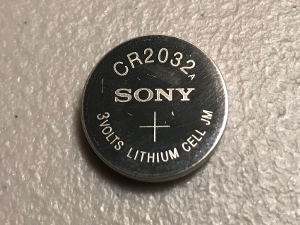
THE WINNER
CONDUCTIVE MATERIAL

THE WINNER
INVESTIGATION RESULTS
![]() The conductive fabric cloth was easy to work with, but not what we needed, because we only wanted one side of the material to have adhesive. Check back with us later though because we can’t wait to start an investigation into cool uses for this material.
The conductive fabric cloth was easy to work with, but not what we needed, because we only wanted one side of the material to have adhesive. Check back with us later though because we can’t wait to start an investigation into cool uses for this material.![]()
![]()
![]()
![]()
LEDs

THE WINNER
INVESTIGATION RESULTS
![]() The 5mm LEDs were a little too big for our needs but you may want to keep some handy for future projects.
The 5mm LEDs were a little too big for our needs but you may want to keep some handy for future projects.![]()
Trouble Shooting
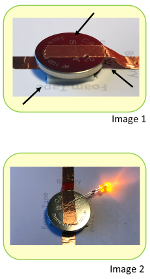 1.1 Make sure the battery has been attached to the foam tape with the positive side up. If the copper tape is covering the ‘+’ symbol, you should still be able to see other markings. The coin cell batteries we’ve used have all had the markings on the positive side of the battery only (Image 1, top arrow).
1.1 Make sure the battery has been attached to the foam tape with the positive side up. If the copper tape is covering the ‘+’ symbol, you should still be able to see other markings. The coin cell batteries we’ve used have all had the markings on the positive side of the battery only (Image 1, top arrow).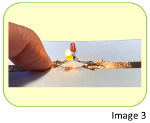 Note: Bend the legs of the working LED from step 1.4 above outward enough to bridge the LED gaps in the circuit. Use it below:
Note: Bend the legs of the working LED from step 1.4 above outward enough to bridge the LED gaps in the circuit. Use it below:

Pull Tab
(printable instructions)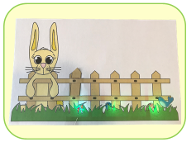
Step 1 – Supplies:
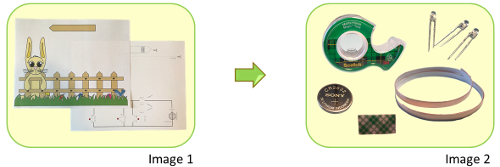
Step 2 – Testing:
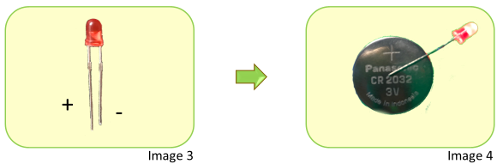
Step 3 – Build:


3.1Locate two scissor symbols, one at each end of the horizontal dotted line, on the back of the template, near the top. Cut along the dotted line to remove the strip that contains the fence post switch and set aside for later (Image 7 & 8). Pressure Sensor
(printable instructions)
Step 1 – Supplies:
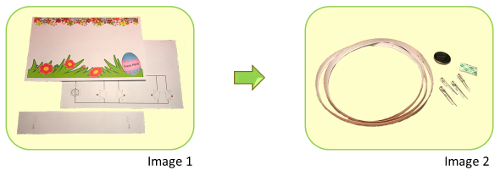
Step 2 – Testing:

Step 3 – Build:



Dot-To-Dot
(printable instructions)
Step 1 – Supplies:
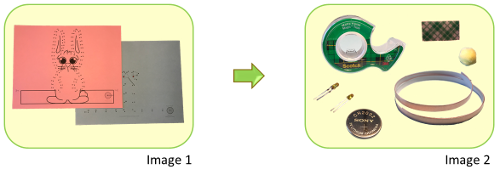
Step 2 – Testing:

Step 3 – Build:
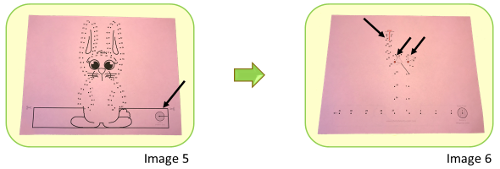

3.1 Use a crayon or colored pencil to complete the Easter Bunny dot to dot on the front of the template (Image 7).
3.2 Cut out the Easter Bunny template, following the solid black line that forms the base for the stand and the dot to dot outline from step 3.1 that forms the Easter Bunny (Image 8).
